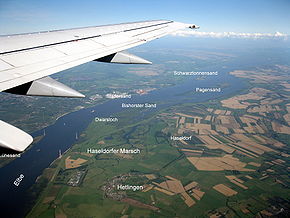Haseldorfer March
The Haseldorfer Marsch is the smallest of the Holstein Elbe marshes and is located northeast of the Elbe between the town of Wedel , the Pinnau and the Geestrand between Uetersen and Holm . The main town of the Haseldorfer Marsch is the community Haseldorf ; other communities are Haselau and Hetlingen . On the opposite bank of the Elbe is the city of Stade , about 20 kilometers west of Hamburg . The Haseldorfer Marsch is part of the Pinneberg district in Schleswig-Holstein . The village of Bishorst, submerged in the Elbe, was also located in it . The second oldest functioning swing bridge in Germany, which was built in 1887, is located at the transition to the Seestermüher Marsch . The residents of the march always had to deal with storm surges and floods.
Events
On the night of December 28, 1248, the so-called Allerkind flood destroyed parts of the first dyke system. Large parts of the area were devastated.
During the Hamburg storm surge on 16./17. In February 1962 the march was partially flooded meters high. The Hetlinger Schanze and the Haseldorfer Vorland were up to 5.83 meters under water. However, the Elbe dyke did not break. But the dyke heightening, which was poorly carried out at the end of the 1950s, made itself felt. So the new dike crest at Hetlingen simply sagged. Due to the flood backlog on the Pinnau river dike , there were further floods in the nearby Uetersen . Unlike in Hamburg , there were no fatalities, but the damage to the buildings and infrastructure was the same as in Hamburg-Wilhelmsburg and Georgswerder .
On January 3, 1976, in the wake of the Capella storm, it was hit by a storm surge again. The dike near Hetlingen broke in nine places and the entire march was flooded. The state of emergency prevailed for two weeks, and millions of euros were lost. No one was killed. A total of around 800 families were cut off from the outside world for days. Most of the losses were among farm animals and wildlife. 155 cattle , 610 pigs , 280 sheep and 700 chickens were killed. Around 700 deer , 3000 pheasants and around 1000 hares lost their lives.
In July 2002 torrential rains flooded the Haseldorfer Marsch. Up to 125 liters of water per square meter fell in 24 hours. Further water masses came from the Geesthang near Hetlingen. The orchards, houses and streets were under water. Over 300 firefighters as well as the THW and the DRK were in action for days.
Agriculture and recreational area
The Haseldorfer Marsch is still mainly used for agriculture today, the most important branch being fruit growing ; In addition, the livestock is important. Due to its proximity to Hamburg , many commuters who work in Hamburg live in the Haseldorfer Marsch. The march is also a popular recreational destination for the people living in the surrounding area.
Web links
- Rolf and Elisabeth-Juliane Herrmann: Haseldorfer March .
- NABU Nature Center Haseldorfer Marsch
Coordinates: 53 ° 38 ′ 35 ″ N , 9 ° 36 ′ 18 ″ E
Individual evidence
- ↑ When the Haseldorfer Marsch sank , NDR January 3, 2016, accessed on April 20, 2019





